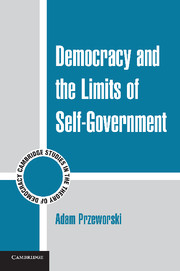Book contents
3 - A Brief History of Representative Institutions
Published online by Cambridge University Press: 05 June 2012
Summary
FROM REPRESENTATIVE INSTITUTIONS TO DEMOCRACY
Before delving into the analysis, it should be helpful to have at least a brief historical background. What follows in this chapter are some stylized facts, without any attempt at explanations. Additional facts are provided in the subsequent chapters, where they are most relevant. This chapter begins with an overall glance and then enters into some details.
Modern representative institutions are those that combine lower houses of legislatures elected on the basis of individual suffrage (even if restricted but as distinct from estate or corporate representation), separation of executive from legislative functions, the power of legislatures to convoke themselves (even if they could be dissolved), and the placement of taxing power in legislatures. While recent research dug up a variety of legislative assemblies in various parts of Europe already in the late medieval period and, indeed, in quite a few in other places around the world, systems of representative institutions as defined here first emerged in England and in Poland, where they can be dated discretely to 1493 (Jȩdruch 1998). The War of Independence in the United States resulted in the first appearance of such institutions in the Western Hemisphere. They were first established in France in 1789 and in Spain in 1812. After Poland lost independence in 1795, England, the United States, France, and Spain became the paragons of institutional engineering for countries in Latin America that became independent after 1810 and in Europe, beginning with Norway in 1814.
- Type
- Chapter
- Information
- Democracy and the Limits of Self-Government , pp. 44 - 65Publisher: Cambridge University PressPrint publication year: 2010



